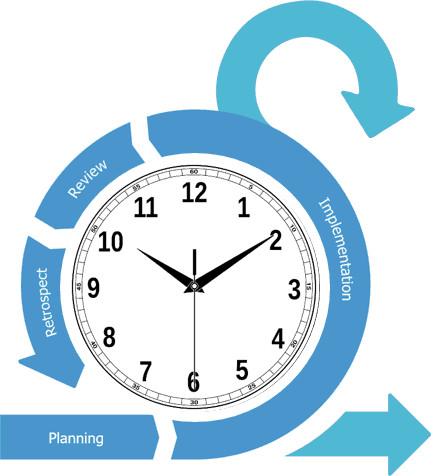
Likely one of the biggest challenges of Agile teams is developing into a highly performing team, in a short period of time… Time-boxing is one of the practices which supports this as Agile teams complete iterative work. Time-boxing is an approach to time management where time-boxes are used. A time-box is a defined period, during which task(s) must be completed. In traditional project management, if the plan duration is exceeded, work continues until all of the planned work has been completed. With time-boxing when the duration ends the work ends, even if all that was planned for the time-box is not completed. Basically time-boxing forces prioritization, improves efficiency, improves throughput, and fundamentally improves performance. These are some of the results when teams or individuals use time-boxing.
A few years ago, I conducted a professional experiment with my business… I applied time-boxing to my daily work…
Experiment: For a few months (about 3-4), I decreased my work day from 10-11 hours to 6 hours each day! I started working 8-hour days, but my days slowly expanded to 9, 10, 11, and sometimes even 13-hour days!
Background/ Problem: My training and consulting work had ‘scope crept’ into my life… I would start work at 7:30am and finish at 8pm, or sometimes later into the evening. I would take a break at lunch, and sometimes go for a walk, and then later at dinner. I would work 10+ hours each weekday and often work 6-8 hours on the weekend days.
Discovery: What I found was, since I knew I had to stop working after 6 hours every day, I focused only on the work that I had to complete that day and then once completed, I did the next highest prioritized work. Time-boxing forced me into prioritizing, and ironically, although I worked many less hours (in some cases half the hours I previously worked), I was accomplishing more! More importantly I was accomplishing the things that were most valuable to my customers! Part of the reason I think I accomplished more, is due to my focus and diligence to stay on task so that I could complete my work in the time-boxed period. The other element was that time boxing forced me to do the highest priority work first as I was committed to only working six hours each day.
Results:
- I had more free time, which I used for research, reading, and writing.
- I had more work / life balance, which equates to less stress, better rest, improved health, lots of good things, etc.
- I accomplished more! Really, this is the most notable result. I actually accomplished more in the 6 hours I worked every day then when I was working 10-12-hour days!
I did get a few hecklers saying they wished they could work only 6 hours / day but unfortunately were employed for 8 or 10, as salaried employees. But honestly, I ended up working another 2 hours each day, but I used that ‘extra time’ to focus on self-training and reading. I did things that Stephen Covey would call, ‘important but not urgent’. These important but not urgent tasks are the ones that I think best support professional growth and development, and support the growth and development of one’s organization.
I am happy to say, I also obtained wonderful support from other independent workers or entrepreneurs that I know. There is some common knowledge and agreement that working less hours, taking more vacation time, or longer vacation leads to greater innovation and productivity for employees, independent workers, or business owners.
Basically, time-boxing forces prioritization, improves efficiency, improves throughput, and fundamentally improves performance. These are the results when teams or individuals use time-boxing. So, consider that time boxing isn’t just for your Scrum team, but is something you can employ in the work you do on a daily or weekly basis!
If you’re interested in learning more about agile practices or you’re interested in an agile certification please attend my free webinar, which will provide you with information on the PMI-ACP certification prep course that I teach for PMO Advisory.

